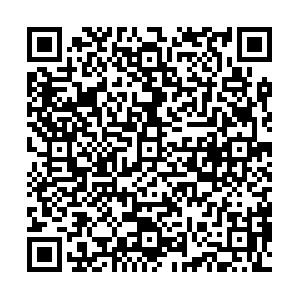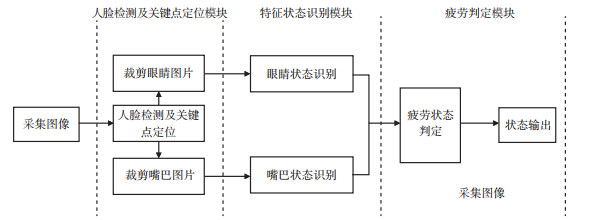A Detection Algorithm for the Fatigue of Ship Officers Based on Deep Learning Technique
-
摘要: 针对日益凸显的船舶值班人员疲劳驾驶问题,为有效预警值班驾驶员的疲劳状态,保障船舶航行安全,研究了基于深度学习的疲劳检测算法。考虑到船舶驾驶台空间大、背景复杂等特点,使用深度可分离卷积改进RetinaFace人脸检测模型,优化模型的检测速度;基于Channel Split和Channel Shuffle思想,结合批量归一化、全局平均池化等技术搭建改进的ShuffleNetV2网络,自动提取图像特征,识别眼睛、嘴巴的开闭状态;根据PERCLOS准则融合眼睛、嘴巴2个特征参数综合判定驾驶员是否疲劳。实验结果表明:改进后RetinaFace模型的检测速度由9.33帧/s提升至22.60帧/s,人脸检测精度和速度均优于多任务卷积神经网络(MTCNN);改进的ShuffleNetV2网络识别眼睛、嘴巴状态的准确率高达99.50%以上;算法在模拟驾驶台环境中识别疲劳状态的精确率达到95.70%,召回率达到96.73%,均高于目前常见的Haar-like+Adaboost以及MTCNN+CNN疲劳检测算法。算法检测每帧图片仅需0.083 s,基本满足实时检测的要求。
-
关键词:
- 交通安全 /
- 疲劳检测 /
- RetinaFace /
- ShuffleNetV2 /
- PERCLOS准则
Abstract: Aiming at preventing Officers on Watch (OOW) from fatigue driving, a fatigue detection and alert algorithm based on deep learning technique is developed. Considering the large space and complex background of the ship bridge, the RetinaFace model is improved by using Depthwise Separable Convolution to optimize the detection speed. An upgraded ShuffleNetV2 network is then developed by adopting the concepts of Channel Split, Channel Shuffle, and other techniques such as batch normalization and global average pooling. The proposed algorithm can extract image features and automatically identify the opening and closing of the eyes and mouth of the OOW. According to the PERCLOS criteria, the two features of the eyes and mouth are integrated to determine whether the OOW is fatigued. Experimental results show that the detection speed of the improved RetinaFace model improves from 9.33 to 22.60 frames/s. The detection accuracy and speed for the face detection are superior to the multi-task convolutional neural network. The upgraded ShuffleNetV2 network achieves over 99.50% accuracy in recognizing the states of eyes and mouth. The algorithm has an accuracy of 95.70% and a recall rate of 96.73% in identifying the fatigue state in a simulated ship bridge scenario, which are higher than Haar-like+Adaboost and MTCNN+CNN fatigue detection algorithmsused in practice. It only takes 0.083 s for the algorithm to complete the process, which indicates that the algorithm is capable of carrying out real-time detection.-
Key words:
- transport safety /
- fatigue detection /
- RetinaFace /
- ShuffleNetV2 /
- PERCLOS
-
表 1 不同模型在自建眼睛数据集上的分类对比
Table 1. Classification comparison of different models on self-built eye dataset
算法 准确率 速度/(ms/帧) LeNet 95.53 12 VGG16 97.88 16 MobileNetV2 97.43 9 本文模型 99.71 7 表 2 不同疲劳检测算法结果对比
Table 2. Comparison of different fatigue detection algorithms
算法 Nt Nd Np 精确率p/% 召回率R/% Haar-like+Adaboost 92 96 75 78.12 81.52 MTCNN+CNN 92 94 84 89.36 91.30 本文算法 92 93 89 95.70 96.73 -
[1] 郭其顺. 世界海难事故的现状与原因分析[J]. 中国船检, 2000(3): 44-46. https://www.cnki.com.cn/Article/CJFDTOTAL-ZGCJ200003030.htmGUO Q S. Current situation and cause analysis of maritime accidents in the world[J]. China Ship Survey, 2000(3): 44-46. (in Chinese) https://www.cnki.com.cn/Article/CJFDTOTAL-ZGCJ200003030.htm [2] 张堃. 船舶机舱值班人员眼部视觉识别及疲劳状态监测[D]. 大连: 大连海事大学, 2019.ZHANG K. Eye visual recognition and fatigue monitoring of engineering watch-keepers on board ship[D]. Dalian: Dalian Maritime University, 2019. (in Chinese) [3] 刘建蓓, 马小龙, 张志伟, 等. 基于心电分析的青藏高原驾驶人疲劳特性[J]. 交通运输工程学报, 2016, 16(4): 151-158. doi: 10.3969/j.issn.1671-1637.2016.04.016LIU J B, MA X L, ZHANG Z W, et al. Fatigue characteristics of driver in Qinghai-Tibet Plateau based on electrocardiogram analysis[J]. Journal of Traffic and Transportation Engineering, 2016, 16(4): 151-158. (in Chinese) doi: 10.3969/j.issn.1671-1637.2016.04.016 [4] LAWOYIN S, FEI D Y, BAI O. Accelerometer-based steering-wheel movement monitoring for drowsy-driving detection[J]. Journal of automobile engineering, 2015, 229(2): 163-173. doi: 10.1177/0954407014536148 [5] 刘梦佳, 赵建国. 基于SVM的疲劳驾驶人脸图像特征检测算法[J]. 半导体光电, 2020, 41(2): 278-282. https://www.cnki.com.cn/Article/CJFDTOTAL-BDTG202002026.htmLIU M J, ZHAO J G. Research on feature detection algorithm of fatigue driving face image based on SVM[J]. Semiconductor Optoelectronics, 2020, 41(2): 278-282. (in Chinese) https://www.cnki.com.cn/Article/CJFDTOTAL-BDTG202002026.htm [6] 王迪. 基于人眼状态的疲劳检测算法研究与应用[D]. 成都: 电子科技大学, 2020.WANG D. Research and application of fatigue detection algorithm based on human eye state[D]. Chengdu: University of Electronic Science and Technology of China, 2020. (in Chinese) [7] 黄玲, 洪佩鑫, 吴泽荣, 等. 基于防疫常态化的驾驶员疲劳状态检测方法[J]. 交通信息与安全, 2021, 39(4): 26-34. doi: 10.3963/j.jssn.1674-4861.2021.04.004HUANG L, HONG P X, WU Z R, et al. A detection method for drivers' fatigue states based on normalization of epidemic prevention[J]. Journal of Transport Information and Safety, 2021, 39(4): 26-34. (in Chinese) doi: 10.3963/j.jssn.1674-4861.2021.04.004 [8] 张博雅. 基于深度学习的驾驶安全评估方法研究[D]. 西安: 西安科技大学, 2019.ZHANG B Y. Research on driving safety assessment method based on deep learing[D]. Xi'an: Xi'an University Of Science And Technology, 2019. (in Chinese) [9] LIU Z M, PENG Y X, HU W J. Driver fatigue detection based on deeply-learned facial expression representation[J]. Journal of Visual Communication and Image Representation, 2020 (71): 102-107. [10] 郭佳伟. 基于计算机视觉的驾驶员异常行为识别与预警[D]. 大连: 大连海事大学, 2019.GUO J W. Driver's abnormal behavior recognition and early-warning based on computation vision[D]. Dalian: Dalian Maritime University, 2019. (in Chinese) [11] LI K N, GONG Y B, REN Z L. A fatigue driving detection algorithm based on facial multi-feature fusion[J]. IEEE Access, 2020, 8(11): 244-259. [12] 陈军, 张黎, 周博, 等. 基于级联卷积神经网络的驾驶员分心驾驶行为检测[J]. 科学技术与工程, 2020, 20(14): 5702-5708. doi: 10.3969/j.issn.1671-1815.2020.14.037CHEN J, ZHANG L, ZHOU B, et al. Driver distracted driving behavior detection based on cascaded convolutional neural network[J]. Science Technology and Engineering, 2020, 20(14): 5702-5708. (in Chinese) doi: 10.3969/j.issn.1671-1815.2020.14.037 [13] DENG J K, GUO J, VERVERAS E, et al. Retinaface: Single-shot multi-level face localisation in the wild[C]. The IEEE conference on computer vision and pattern recognition, Seattle: IEEE, 2020. [14] GAVAI N R, JAKHADE Y A, TRIBHUVAN S A, et al. MobileNets for flower classification using TensorFlow[C]. 2017 International Conference on Big Data, IoT and Data Science (BID), Pune: IEEE, 2017. [15] YANG S, LUO P, LOY C C, et al. Wider face: A face detection benchmark[C]. The IEEE Conference on Computer Vision and Pattern Recognition, Las Vegas: IEEE, 2016. [16] ZHANG K P, ZHANG Z P, LI Z F, et al. Joint face detection and alignment using multitask cascaded convolutional networks[J]. IEEE Signal Processing Letters, 2016, 23(10): 1499-1503. doi: 10.1109/LSP.2016.2603342 [17] MA N N, ZHANG X Y, ZHENG H T, et al. ShuffleNet V2: practical guidelines for efficient CNN architecture design[C]. European Conference on Computer Vision, Munich: ECCV, 2018. [18] IOFFE S, SZEGEDY C. Batch normalization: Accelerating deep network training by reducing internal covariate Shift[C]. International Conference on Machine Learning, Lille: PMLR, 2015. [19] PENG Y, DONG Y, CHENG D. Design and implementation of a driver's eye state recognition algorithm based on PERCLOS[J]. Chinese Journal of Electronics, 2014, 23(4): 669-672. [20] ABTAHI S, OMIDYEGANEH M, SHIRMOHAMMADI S, et al. YawDD: A yawning detection dataset[C]. The 5th ACM multimedia systems conference, Singapore: ACM, 2014. -





 下载:
下载:












